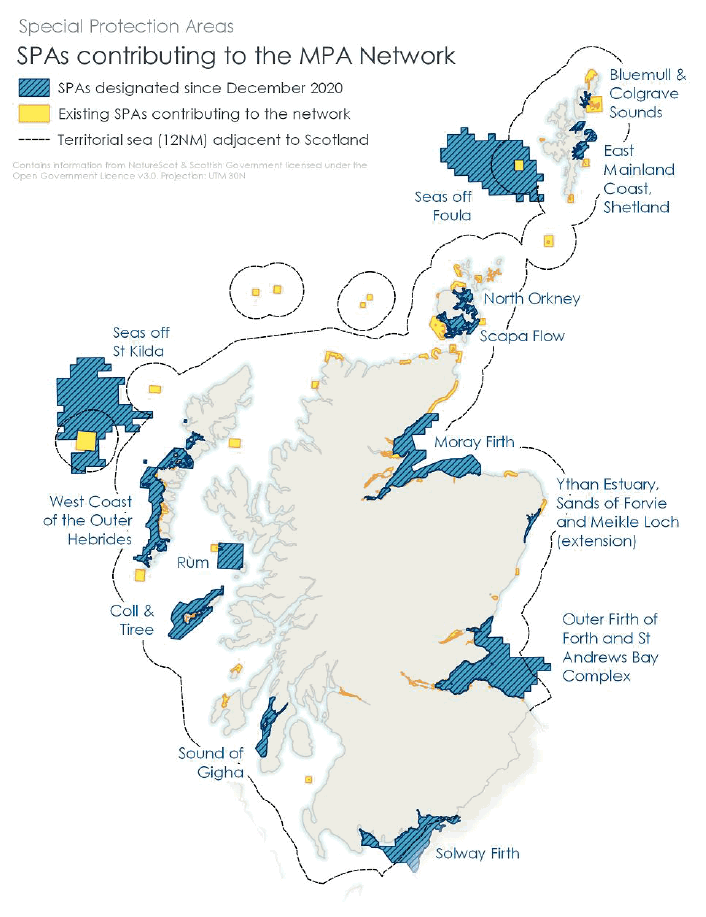Marine proposed Special Protection Areas strategic environmental assessment: post adoption statement
A strategic environmental assessment post adoption statement setting out how the assessment and consultation responses have been taken into account in the introduction of Special Protection Areas.
1 Background
1.1.1 Marine Scotland is committed to a clean, healthy, safe, productive and biologically diverse marine and coastal environment that meets the long term needs of people and nature. The designation and management of Marine Protected Areas (MPAs), including Special Protection Areas (SPAs), will make a significant contribution to the protection, enhancement and health of the marine area[1].
1.1.2 Following the UK leaving the EU, the Conservation (Natural Habitats, &c.) Regulations 1994[2],[3], the Conservation of Habitats and Species Regulations 2017[4], the Conservation of Offshore Marine Habitats and Species Regulations 2017[5] and the Offshore Petroleum Activities (Conservation of Habitats) Regulations 2001[6] (collectively known as the Habitats Regulations) have been amended by the Conservation of Habitats and Species (Amendment) (EU Exit) Regulations 2019[7]. These changes ensure that the requirements of the EU Birds Directive 2009/147/EC[8] are a part of UK domestic legislation, and continue to apply to how SPAs are classified and protected[9].
1.1.3 Previous consultation exercises were undertaken in 2016/2017 on a proposed network of 15 marine SPAs in UK Waters[10]. Building on the work of the SPA Review Working Group and taking account of existing guidelines on the identification of SPAs[11], NatureScot (formerly Scottish Natural Heritage), the Joint Nature Conservation Committee (JNCC) and Natural England identified 15 sites based on the scientific evidence and selection process which they considered essential for marine SPA status. These proposals included sites supporting wintering waterfowl, seabird aggregations, important areas for foraging breeding red-throated divers, breeding terns, and breeding and non-breeding European shag.
1.1.4 The proposal to classify these additional SPAs in the Scottish marine environment was subject to a Strategic Environmental Assessment (SEA) and an Environmental Report[12] ('the 2018 Environmental Report') was published on 14 September 2018 for consultation in accordance with the Environmental Assessment (Scotland) Act 2005 ('the 2005 Act').
1.1.5 Following substantive scientific objections raised during the 2018 consultation, NatureScot and JNCC's Final Advice[13] on the proposed network provided some recommended changes to the marine proposed SPAs (pSPAs), the most notable of which was the withdrawal of the Pentland Firth pSPA from the plan. In order to address this change and also other consultee responses, specifically with regard to the previous assessment of reasonable alternatives in the 2018 Environmental Report, the Scottish Government undertook a supplementary consultation based upon a revised and expanded set of SEA Reasonable Alternatives. These were subject to further assessment in an updated Environmental Report which was published for consultation on 17 June 2019 ('the 2019 Updated Environmental Report')[14].
1.1.6 Following the supplementary consultation, 12 of the pSPAs were classified on 3 December 2020[15]. These sites were:
- Solway Firth;
- Seas off St Kilda;
- Seas off Foula;
- Outer Firth of Forth and St Andrews Bay Complex;
- Moray Firth;
- Ythan Estuary, Sands of Forvie, and Meikle Loch (extension);
- Bluemull and Colgrave Sounds;
- East Mainland Coast, Shetland;
- Sound of Gigha;
- Coll and Tiree;
- Rum; and
- West Coast of the Outer Hebrides.
1.1.7 Marine Scotland engaged directly with Orkney Islands Council to address a number of objections they had to the proposals. As a result, the option to classify Orkney Inshore Waters as a single pSPA was discounted and on 16 February 2022, the alternative option was taken forward and two SPAs were classified[16], namely:
- North Orkney; and
- Scapa Flow.
1.1.8 Following on from this engagement, Marine Scotland has developed a working partnership with Orkney Islands Council and NatureScot. Together they have jointly funded a series of aerial and vantage point birds surveys to ensure there is a higher quality baseline dataset from which more robust decisions can be made on the management of these sites.
1.1.9 The location of the 14 additional marine SPAs that have been classified are shown in Figure 1. Following the classification of these SPAs, Scotland now has 58 marine SPAs, 55 of which are in Scottish inshore waters and three which overlap both inshore and offshore waters.

Contact
Email: marine_conservation@gov.scot
There is a problem
Thanks for your feedback